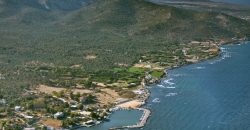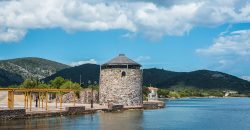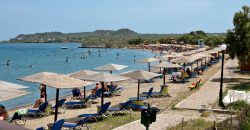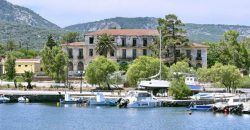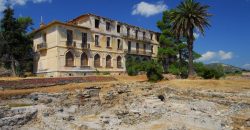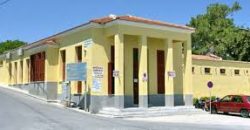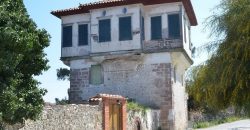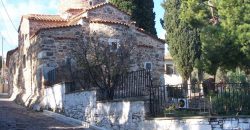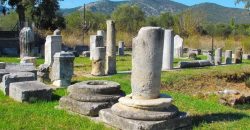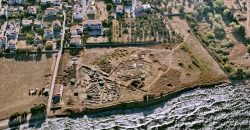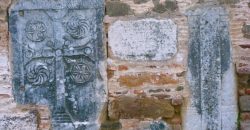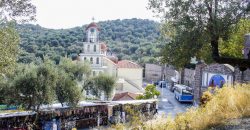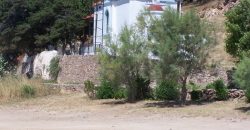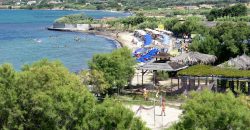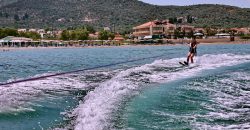Loutropoli Thermis is formed by the villages: Pyrgi Thermis, Thermi, Pigi, Komi, Nees Kydonies and Mystegna. 11 kilometres, on the northeast side of the town of Mytilini, we find the village of Pirgi Thermis. 10 kilometres further from that village, on the east coast, we find the village of Nees Kydonies.Between these two villages, which are the physical boundary of the Municipality of Loutropoli Thermis, we see the villages and the fish-ports that belong to this Municipality.
Municipality named after its natural hot springs.
The history of the name’ s origin dates back to the Hellenistic and Roman Era, when the Greeks and the Romans had built a group of public bath-rooms taking advantage of the area’ s natural gift and its healing abilities and turning the town into a summer resort. We should not forget to mention that at the same area, the inhabitants used to worship the goddess Artemis, the natural hot springs’ protector.
The endless olive grooves, the oleanders and the osiers, all over the ravines, compose the greenest landscape on the island. The medieval rural villages, hidden among the hills, still remain intact from the modern tourism’ s effects. The past of this place is all over the place obvious; through the marble bas-relief on the traditional houses’ walls, through the ancient columns on the houses’ thresholds, through the ancient pots’ fragments shattered all over the area’ s coasts, through the miraculous monasteries, as well as the old churches and chapels
There is no doubt that, when the first inhabitants settled down at this area during the 3rd millennium a. C, they would have found Thermi covered with a natural forest, Mediterranean bushes and endless pine-trees’ forests, like those we find today in our way to Pigi and to Nees Kydonies.
These forests were of great importance for the inhabitants, as they needed material for their constructions, their boats, cooking and heating, but mostly for their pottery furnaces. So, the inhabitants had started to denude the plain of the trees, having this way material and free space for their cultivations and the construction of their villages.
5000 years later… At the beginning of the 20th century, the English archaeologist Lamb visits the area.
From the excavations that took place, there were found 5 prehistoric villages belonging to the Early Copper Era (2800-2400 a. C) and two villages belonging to the Post Copper Era (1600-1200 a. C), built the one above the other and forming this way a small hill.
Since then, the sea level has risen three metres “rinsing”, this way, half of the hill, removing the prehistoric houses’ stones from the hill and accumulating them on the seashore. After the excavation, this archaeological site has been covered again with soil, for reasons of protection. Anyone who observes, at the archaeological museum, the exhibition of this rare prehistoric collection of ceramics coming from the area of Thermi, can not help asking himself about the slow rhythm with which the art of pottery has been developed until nowadays, 5000 years later.
We should mention that during the Ottoman Occupation, at the beginning of the 19th century, there have been constructed the modern bath-rooms with separated baths made of marble. Restored in 1997 and work until today. Most of the fountains that we find in the villages and on the old streets date back to the Ottoman Era. At the end of the 19th century, a Turkish businessman finances the construction of the hotel Sarlitza (meaning Yellow Spring)
During the decade of 70s it stopped working due to bureaucratic reasons, not being able to deal with the new conception that regarded vacations. But the “Sarlitza Pallas” had been for many decades the most “in” hotel on the island and had managed to give back to Thermi some of the lost splendour of the Roman Era.
Although Lesbos had been liberated since 1912 by the Greek fleet, the Greeks went on living peacefully together with the Turkish people on the island, until 1922.The treaty of Lozane that ended the war between the two countries resulted to a massive exchange of the population. The Greeks of the Minor Asia had to come back to Greece and the Muslims had to go back to Turkey.
Most of the Greek refugees had settled down to the villages of Pirgi Thermis, Komi and Nees Kydonies.

